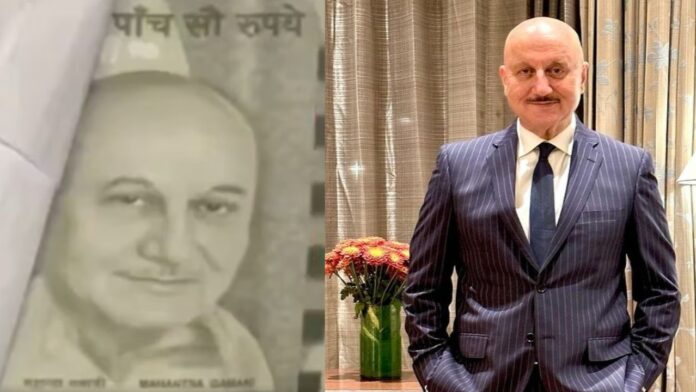The Great Gold Heist: How 3 Fraudsters Used Fake Currency With Anupam Kher’s Face To Dupe A Bullion Trader
In a bizarre and audacious con, three men duped a bullion trader in Ahmedabad out of 2.1kg of gold by using prop currency notes featuring Bollywood actor Anupam Kher’s photograph. The crime, which took place on September 24 in the city’s Navrangpura area, has now led to the arrest of the accused by the city police’s crime branch. The case has shocked both the public and authorities for the ingenuity and boldness involved.

The mastermind behind the con, 32-year-old Deepak Rajput, was no stranger to fraud. According to police reports, Rajput is a seasoned criminal with a long list of fraud cases against him. Among these is a case registered in Ahmedabad’s Vadaj police station, in which Rajput allegedly duped an individual of 40kg of gold using a similar trick, mixing blank paper with real currency notes. His criminal history paints the picture of a man well-versed in manipulating legal loopholes and exploiting trust to carry out elaborate scams.
This time, however, Rajput went a step further by printing fake ₹500 currency notes with the face of actor Anupam Kher instead of Mahatma Gandhi. Police believe Rajput chose to use Kher’s photograph due to his knowledge of legal distinctions between counterfeit currency and imitation or prop currency. The latter, which is often used in the entertainment industry or for children’s play, carries less severe legal penalties than counterfeit notes. This move was a calculated attempt to evade harsher charges associated with counterfeiting.
Rajput’s partners in crime, Narendra Yadav alias Nandu (36) and Kalpesh Mehta (45), were also arrested. Mehta played a key role in executing the fraud by printing the fake notes and forging supporting documents, including a counterfeit SBI passbook, to lend credibility to their deceitful scheme. Their teamwork and careful planning allowed them to pull off the gold heist, albeit temporarily, before being tracked down by the authorities.
)
The plot began to unfold when Rajput contacted Bharat Joshi, an employee of bullion trader Mehul Thakkar. Rajput expressed his intent to buy 2.1kg of gold, offering to exchange it for cash. He arranged for the handover to take place at an outlet in a shopping complex on C.G. Road in Ahmedabad. Rajput told Joshi that the premises belonged to a local angadia service, commonly used for transporting cash and jewellery. In reality, Rajput’s associate had rented the space just two days before the planned heist, using it as a front for the transaction.
On the day of the exchange, Rajput and Nandu handed over 26 bundles of prop ₹500 notes, amounting to ₹1.3 crore, to Joshi at the angadia office. They assured Joshi that they would return with the remaining ₹30 lakh required to complete the purchase. Trusting their promise, Joshi handed over the 2.1kg of gold. However, as he began counting the bundles of cash using a machine, he quickly discovered the ruse. Each of the notes bore Anupam Kher’s face, not Mahatma Gandhi’s. By the time Joshi realized what had happened, Rajput and his associates had vanished with the gold.
The audacity of the conmen, coupled with their use of prop currency, made this case stand out for its sheer boldness. Despite the bizarre choice of using an actor’s face on the notes, the gang’s plan initially succeeded due to their meticulous preparation and ability to win over Joshi’s trust. However, their escape was short-lived.

As soon as the scam came to light, the police were called in to investigate. The crime branch, known for handling high-profile cases, took charge of the investigation. The team began by examining CCTV footage from the shopping complex and surrounding areas. The footage provided crucial evidence that allowed the police to track the suspects, including their movements leading up to the handover of the gold and their eventual disappearance.
According to the police, Rajput had carefully studied legal loopholes to minimize his risk of being caught for counterfeiting. By using imitation notes, he attempted to avoid the severe penalties that accompany the production of counterfeit currency. While the law differentiates between real counterfeit money and imitation notes used for movies or entertainment, the deception involved in this case led to the culprits being booked under various sections of the Bharatiya Nyay Sanhita (BNS). These include Section 61 for criminal conspiracy, Section 316 for criminal breach of trust, and Section 318 for cheating and dishonestly inducing the delivery of property.
The arrest of the three men brings a temporary closure to the case, though it also highlights the extent to which criminals can manipulate legal nuances to their advantage. Rajput’s previous record, including a case of duping an individual of 40kg of gold, suggests that this was not his first elaborate con, nor would it likely have been his last if he hadn’t been caught. His decision to use imitation currency with Anupam Kher’s photograph shows the lengths criminals will go to in order to evade severe punishment while still engaging in large-scale fraud.
The case serves as a reminder for traders, particularly those dealing in high-value commodities like gold, to exercise extreme caution during transactions. While the arrest of the accused provides some relief, it also underscores the need for constant vigilance and awareness in a world where fraudsters are becoming increasingly creative in their tactics. For now, Rajput, Nandu, and Mehta will face the legal consequences of their actions, but the strange tale of how they used fake money with Anupam Kher’s face will remain a curious footnote in the annals of crime.

